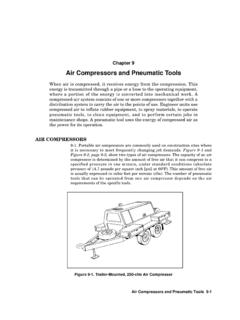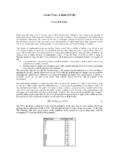Transcription of Method A3 - Interval Test Method - Measurement uncertainty
1 Method A3 Interval Test Method Description of the Methodology 2003-2010, Integrated Sciences Group, All Rights Reserved. Not for Resale ABSTRACT A methodology is described for testing whether a specific calibration Interval is consistent with a given reliability target. the Method is referred to as the Interval test Method or, alternatively, as Method Interval testing computes binomialconfidence limits from an observed reliability. If the reliability target falls outside the confidence limits, the Interval is said to have failed the test. The methodology is embedded in the ISG Method A3 Interval Tester. BACKGROUND Since the late 50s, manufacturing, testing and calibration organizations have periodically calibrated measuring and test equipment (MTE) to ensure that items are in-tolerance during use.
2 It was realized early on that it was virtually impossible to predict the time at which an item would transition from an in-tolerance state to an out-of-tolerance state. Alternatively, what has been attempted is to find an Interval of time between calibrations that results in holding the percentage of items in use to a minimum acceptable level. This percentage is called the reliability target. Intervals of time between calibrations are referred to as resubmission times. Resubmission times are to be contrasted with assigned recall cycles for ensuring in-tolerance. The latter are called calibration intervals. STATISTICAL methods Several methods have been devised over the years to control MTE in-tolerance percentages.
3 Some of these methods employ sophisticated statistical techniques to mathematically model in-tolerance probability vs. time elapsed since calibration. These methods are labeled statistical methods . Statistical methods attempt to predict a calibration Interval that corresponds to a specific end-of-period in-tolerance percentage. They require considerable calibration history for analysis and are often difficult to implement. ALGORITHMIC methods Other methods utilize simple to complex decision algorithms to adjust calibration intervals in response to in-tolerance or out-of-tolerance conditions observed during calibration. Typically, these approaches consist of instructions to lengthen or shorten calibration intervals in response to current or recent observations.
4 Because of their nature, these methods are labeled algorithmic methods . Algorithmic methods have achieved wide acceptance due to their simplicity and low cost of implementation. However, most algorithmic methods suffer from several drawbacks. The following list is fairly representative: 1. With most algorithmic methods , Interval changes are in response to small numbers (usually one or two) of observed in-tolerance or out-of-tolerance conditions. It can be easily shown that any given in-tolerance or out-of-tolerance condition is a random occurrence. Adjusting an Interval in response to small numbers of calibration results is, accordingly, equivalent to attempting to control a process by adjusting to random fluctuations.
5 Such practices are inherently futile. 2. Algorithmic methods make no attempt to model underlying uncertainty growth mechanisms. Consequently, if an Interval change is required, the appropriate magnitude of the change cannot be readily determined. 3. Algorithmic methods cannot be readily tailored to prescribed reliability targets that are commensurate with quality objectives. The level of reliability attainable with a given algorithmic Method can be discovered only by trial and error or by ,3,4 1 Establishment and Adjustment of Calibration Intervals, Recommended Practice RP-1, National Conference of Standards Laboratories, January 1996. 2 Jackson, D., Ferling, J.
6 And Castrup, H., Concept Analysis for Serial number Based Calibration Intervals, Proc. 1986 Meas. Sci. Conf., Irvine, January 23-24. Integrated Sciences Group 1-661-872-1683 4. If an Interval is attained that is consistent with a desired level of reliability, the results of the next calibration or next few calibrations will likely cause a change away from the correct Interval . To see that this is so, consider cases where reliability targets are high, , 90%. For a 90% target, if the Interval is correct for an item, there is a probability that it will be observed in-tolerance at any given calibration.
7 Likewise, there is a probability that it will be observed in-tolerance at two successive calibrations. With most algorithmic methods , such observations will cause an adjustment away from the item s current Interval . Thus, algorithmic methods tend to cause a change away from a correct Interval in response to events that are highly probable if the Interval is correct. 5. With algorithmic methods , although a correct Interval cannot be maintained, a time-averaged steady-state Measurement reliability can be achieved. The typical time required ranges from fifteen to sixty 6. With algorithmic methods , Interval changes are ordinarily computed manually by calibrating technicians, rather than established via automated methods .
8 Accordingly, operating costs can be high. Method A3 Method A3 was developed to overcome the deficiencies noted in 1, 3, 4 and 5 above. The description of the Method and its implementation in the Method A3 Interval Tester is described in the following sections. RELEVANT VARIABLES Robs = Observed Reliability at the Current Interval Rtarg = Reliability Target Irec = Recommended Interval Itrial = trial value Icur = Current Interval (current assigned Interval ) Ilong = Longest Interval (longest observed resubmission time) Imax = Max Allowed Interval Imin = Min Allowed Interval Q = Interval Rejection Confidence C = Interval Change Confidence INTRODUCTION For calibration Interval analysis, the term reliability refers to the probability that an MTE item or parameter is in-tolerance.
9 The observed reliability for an MTE item or parameter is defined as the fraction of items or parameters that are found to be in-tolerance when tested, calibrated or otherwise inspected. The Method A3 Interval Tester When items are periodically tested or calibrated, the observed reliability is the fraction of items observed to be in-tolerance. If the resubmission time occurs at the end of the item s recall cycle, it is synonymous with the test or calibration Interval . When items are received from an external source and inspected prior to being placed in service, the observed reliability is the fraction of items found to be in-tolerance during inspection. In the present discussion, we represent the observed reliability with the variable Robs.
10 Testing an Interval involves comparing Robs against some the reliability target, denoted Rtarg. 3 Kuster, M., et al., Calibration Interval Adjustment: The Effectiveness of Algorithmic methods , Proc. 2009 NCSLI Workshop and Symposium, San Antonio, July 2009. 4 Kuster, et al., A Quantitative Comparison of Calibration Interval Adjustment methods , Proc. 2010 Meas. Sci. Conf., Pasadena, March 25-26. 5 Jackson, et al., op. cit. - 2 Integrated Sciences Group 1-661-872-1683 With the A3 Interval Tester, the observed reliability is computed by dividing the number of tests (n) conducted at the Current Interval into the number In-Tolerance (x) observed at the Current Interval .










